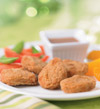
Breaded and battered products continue to enjoy a high demand. To many poultry and some meat manufacturers, they offer opportunities for greater yields and entry into this high-demand product area. Ingredient suppliers say, however, these products can provide a wide range of challenges, such as quality of adhesion, visual and flavor appeal, freezer/thaw stability, moisture and oil transfer, and potential oxidization.
Most fried foods will use some kind of coating that may include a batter, breading, or a combination of both. A batter is often used as a base and functions as a “glue” of sorts, holding the breading to the food product. The majority of batters contain 80 to 90 percent flour and starch, combined with water. Wheat flour is commonly used, however rice, corn, soy and potato flour may also be used. There are also adhesion batters, tempura batters and specialty batters containing herbs and spices that add new flavors to the product.
It is the breading that adds the crunch, flavor and golden-brown color that consumers have come to expect in fried foods. To answer the call, processors use a wide variety of breadings that vary in terms of coarseness, crunchiness and color. Breaded products have evolved beyond the traditional crumb in terms of functionality, potential health benefits, flavor, texture and appearance.
There are many variations among breading formulas, which may include — but are not limited to — a home-style breadcrumb, a Japanese (Panko-type) crumb or specialty breading. Flavor profiles can range anywhere from hot and spicy to bold and ethnic to mild and traditional.
From a sensory standpoint, alternatives to traditional breading systems are providing textures and appearances with an emphasis on new crumb sizes and enriched colors. Layers of exciting flavors reflecting global taste trends are being built into systems that include predusting, batters and breadings.
Changes in breadings and batters take many forms; one of the most prevalent is the makeup of the mixture. New-generation breadings, for example, incorporate everything from grain type (whole, gluten-free, natural/organic and exotic) to subtly different crumb sizes and textures. Mixtures formulated to produce a more acceptable microwavable product are also desirable.
A healthier perspective
Startled to action partly by the low-carb craze that saw some weight-conscious consumers spurn grains-based foods and partly by the obesity epidemic and healthier diet trends, the industry is turning adversity into opportunity by reformulating, redesigning and, in a very real sense, redefining food-coatings systems. The result is an emerging generation of new and enhanced breading/batter/coatings systems friendlier to both processors and consumers.
There are a number of ways that batters and breadings are adapting to today’s health-conscious, flavor-driven marketplace. Driven chiefly by more interest everywhere in whole grains, such breadings are seen as a way to make a clear appeal to the health concerns of growing legions of whole-grains devotees. Plus, they may offer a way to give many maligned breaded foods a healthier halo; in fact, some corn-dog nugget makers are making the switch to whole-grain coatings.From a functionality standpoint, whole grains pose some different challenges and opportunities in processing. Whole grains are ideal for use in breaded products designed to be baked rather than fried. With more baked protein applications emerging, whole-grain coatings might be beneficial. Additionally, using whole grains reduces the need for coloring agents typically used in breadings made from more highly processed grains. However, pricier whole grains also add to ingredient costs.Specialty breadings that may employ a mixture of gluten-free whole grains such as flax, oats or millet pose a challenge as well. Limited availability means they are generally more costly. Additionally, such grains also produce breadings that, when cooked, yield an appearance and texture possibly foreign to the average consumer.
Whole grains are especially gaining in popularity as processors continue to address consumers’ health concerns and perception of breaded products. Poultry processors such as Tyson helped initiate the move, and that has caused others to look at it and inquire as to whether their breadings can be converted to a whole-grains makeup.
“Whole grains are a big part of our development of new products for school lunch items,” says Gary Mickelson, director of media relations for Springdale, Ark.-based Tyson Foods Inc. “Foodservice directors are looking for whole-grain options that are fun and flexible to fit into their menus on a regular basis.”
Currently, Tyson produces two products — the Fully Cooked Whole Grain Chicken Chunk and Pattie — that fit this need.
“These two products have been approved by the Whole Grains Council to carry the Whole Grain Stamp on the label and can be used in multiple menu applications,” notes Mickelson.
As the benefits of whole grain become better known, Mickelson says Tyson will continue to develop new products that have whole grain as part of the breading system to deliver a healthy, yet delicious product for kids, tweens and teens.
Many ingredient manufacturers are also focused on creating tasty products with better texture, but also less fat and sodium. Reducing sodium content, however, presents suppliers with the challenge of formulating more healthful alternatives while delivering the same flavorful appeal.
In addition to healthier sensory profiles, companies are also formulating their coating systems to have lower oil absorption, which results in a lower fat content in the final product. Proteins are being used to block fat absorption during deep-fat frying so that lower-fat breaded foods can be created.
Report Abusive Comment